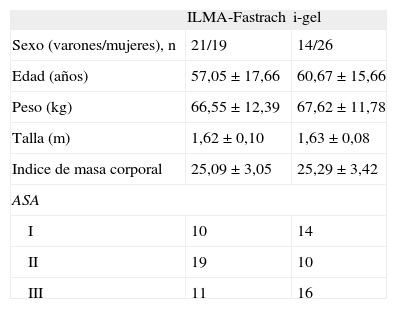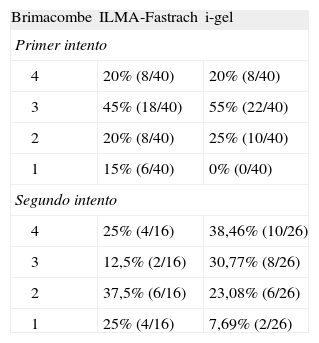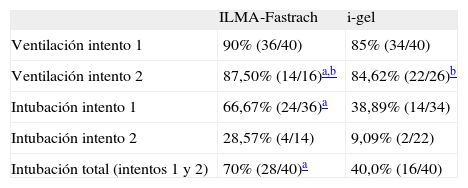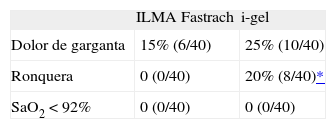El empleo de dispositivos supraglóticos como medida de rescate en pacientes con dificultades para la intubación y/o ventilación se ha incrementado en el ámbito de la anestesia y de la medicina de emergencias. Este estudio se diseñó para evaluar la tasa de éxito de intubación “a ciegas” a través de dos dispositivos supraglóti-cos: la ILMA-Fastrach y la mascarilla i-gel.
Pacientes y métodosSe incluyó a 80 pacientes (40 por grupo). Tras la colocación, se realizó un test de fugas, se comprobó la visión glótica con un fibrobroncoscopio y se intentó la introducción de un tubo endotraqueal a través del dispositivo. Si el intento resultaba fallido, se retiraba el dispositivo y se repetía el procedimiento. Se evaluaron la ventilación adecuada, el grado de visión fibrobroncoscópica, el éxito en la intubación y las complicaciones observadas tras su uso.
ResultadosNo hubo diferencias en la incidencia de ventilación adecuada entre los dis-positivos. La visión glótica (escala de Brimacombe) fue mejor con i-gel (el 77,78 frente al 68,42%) al segundo intento, pero no en el primero. Se consiguió una mayor porcentaje de intubaciones “a ciegas” con ILMA-Fastrach (el 70 frente al 40%; p= 0,013). La incidencia de dolor de garganta fue similar con ambos dispositivos, pero la disfonía postoperatoria fue más frecuente con i-gel (el 20% frente a 0; p = 0,0053).
ConclusionesAmbos dispositivos fueron igual de eficaces para conseguir una adecuada ventilación; sin embargo, ILMA-Fastrach permitió mayor número de intubaciones que i-gel con menos incidencia de disfonía postoperatoria.
The use of supraglottic devices as a means of rescue in patients difficult to intubate or ventilate has increased in the field of anaesthetics and in emergency medicine. This study is designed to evaluate the success rate of blind intubations using two supraglottic devices, the Fastrach ILMA and the i-gel mask.
Patients and methodsA total of 80 patients (40 per group) were included. After positioning them a leak test was performed, the glottis view was checked with a fibrobronchoscope, and an attempt was made to introduce an endotracheal tube through the device, and the procedure was repeated. Adequate ventilation was evaluated, as well as the grade of fibrobronchoscope view, the success of the intubation, and the complications observed after their use.
ResultsThere were no differences in the incidence of adequate ventilation with either device. The glottis view (Brimacombe scale) was better with i-gel (77.78% versus 68.42%) at the second attempt, but not on the first. A higher percentage of intubations were achieved with the Fastrach ILMA (70% versus 40%; P=.013). The incidence of throat pain was similar with both devices, but post-operative dysphonia was more frequent with i-gel (20% versus 0; P=.0053).
ConclusionsBoth devices were equally effective in achieving adequate ventilation; however, the Fastrach ILMA enabled a higher number of intubations to be made than i-gel and with a lower incidence of post-operative dysphonia.
Artículo
Comprando el artículo el PDF del mismo podrá ser descargado
Precio 19,34 €
Comprar ahora












